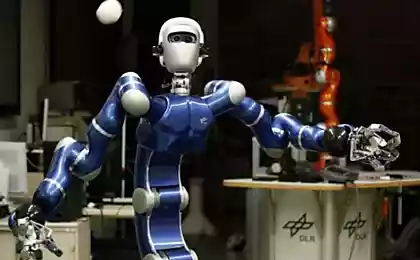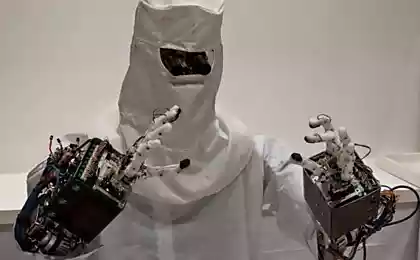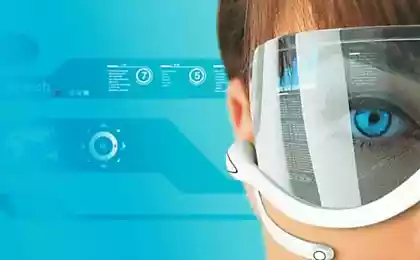2500
Augmented reality helps drivers to see blind spots
Car-robots is difficult to surprise. Already drive prototypes, functional equipment and machinery reminds fighters:

This picture shows the Advanced Driver Assistance System (ADAS), in intended, if not replace the driver, then simplify driving.
ADAS functional controls the switching beam, helps keep the car on the strip, implements adaptive cruise control, detects road signs, detects pedestrians / objects, prevents collisions, the interface implements intelligent 2D and 3D view of the environment, warns of a collision when reversing. Additionally, the system can be expanded with intelligent night vision, long-range radar, laser rangefinder system replaces the side mirrors. It would seem that nothing else could come up with. We can only argue about the reliability of these systems and whether to trust them. But leading Japanese virtual reality lab found another direction to improve traffic safety.
Perhaps you dream of a transparent car racks and door which would not close review?
You are driving on the highway, you can see how the road surface is racing under your feet, the surrounding landscape is visible everywhere - front, back, left, right, top, bottom. Gone are the blind spots created by the doors, pillars, roof and floor. You're free as a bird, and complete control their environment. You like the pilot of the plane flying over the road.
Researchers from the Japanese laboratories Tachi Laboratory / Inami Laboratory thinking about implementing such a vehicle.
Make it a safe car glass impossible. Therefore, the researchers decided to install on the outside of the car camera, and on the racks, doors, ceilings, doors and rear display an image in accordance with the point of view of the driver. As a result of these obstacles, "disappear."
Given the impossibility of insecurity and inappropriate installation LCD-screens instead of whetting the salon, they used the experimental car projectors and special reflective fabric.
But the surface of the interior of the car is not a good screen - uneven surface, and the head of "viewer" is not always in the same place. The image projected on a rough surface will be distorted and that the driver saw the image in proper perspective it is necessary to fix it.
A solution was found with the new system of the projector, which accurately reflects the light back on the path that he had just received. Thus it is possible to project the right image, according to the correct position, right on the "spectator", provided that the projector is close enough to the eyes "viewer". To do this, the projector should be on the person's head ("viewer") or the projector mounted on the ceiling of the cabin, and the displacement and position sensors to track the head.
To simplify the installation of the finished car, without modifying its design, experimental vehicles used the half mirror and the projector is placed below.

Special retroreflective coating gives a vivid picture reflected.
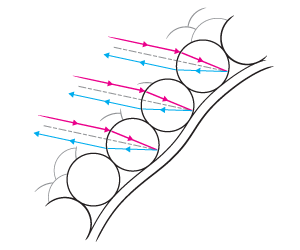
Coating consists of tiny balls refracting light in the opposite direction. With this method the image is 100 times brighter than that achieved with conventional screens. Since the reflection occurs along the projection axis, there is no distortion of the image, even when the image is projected on the screen of complex shape.
This system can also work as a kind of optical camouflage, if people would wear clothes covered with retroreflective beads.
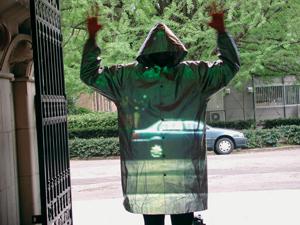

This system is capable of projecting multiple images on a single screen, and thus the technology becomes available for all people being in the vehicle, not only for the driver. To do this you need to install an additional amount of projectors on the number of people inside the vehicle, but it would be very cumbersome solution. Because it was found a workaround with the addition to the existing system "projector screen" only the array of lenses. Each element of the array acts as a single projector, thus creating the appropriate amount of "points of view».
The experimental system, even while reduced functionality, to make visible to the driver of a vehicle blind spots, and the image is bright enough to be visible during the day.
Then, especially for Toyota Prius was created setting that made virtually transparent rear visibility, so that the driver can see everything behind the car when reversing. In this case, the system consisted of a single projector, and the six lenses, which allows the driver to feel natural, compared with a system where the applied tracking head movement of the driver. The result is a panoramic view of the rear-view area.
The system can be used, for example, in aircraft, in cabins cruise ships, manned space flight, and in any other areas where you need to "see through walls».
Demonstration system:
Source: geektimes.ru/post/240902/

This picture shows the Advanced Driver Assistance System (ADAS), in intended, if not replace the driver, then simplify driving.
ADAS functional controls the switching beam, helps keep the car on the strip, implements adaptive cruise control, detects road signs, detects pedestrians / objects, prevents collisions, the interface implements intelligent 2D and 3D view of the environment, warns of a collision when reversing. Additionally, the system can be expanded with intelligent night vision, long-range radar, laser rangefinder system replaces the side mirrors. It would seem that nothing else could come up with. We can only argue about the reliability of these systems and whether to trust them. But leading Japanese virtual reality lab found another direction to improve traffic safety.
Perhaps you dream of a transparent car racks and door which would not close review?
You are driving on the highway, you can see how the road surface is racing under your feet, the surrounding landscape is visible everywhere - front, back, left, right, top, bottom. Gone are the blind spots created by the doors, pillars, roof and floor. You're free as a bird, and complete control their environment. You like the pilot of the plane flying over the road.
Researchers from the Japanese laboratories Tachi Laboratory / Inami Laboratory thinking about implementing such a vehicle.
Make it a safe car glass impossible. Therefore, the researchers decided to install on the outside of the car camera, and on the racks, doors, ceilings, doors and rear display an image in accordance with the point of view of the driver. As a result of these obstacles, "disappear."
Given the impossibility of insecurity and inappropriate installation LCD-screens instead of whetting the salon, they used the experimental car projectors and special reflective fabric.
But the surface of the interior of the car is not a good screen - uneven surface, and the head of "viewer" is not always in the same place. The image projected on a rough surface will be distorted and that the driver saw the image in proper perspective it is necessary to fix it.
A solution was found with the new system of the projector, which accurately reflects the light back on the path that he had just received. Thus it is possible to project the right image, according to the correct position, right on the "spectator", provided that the projector is close enough to the eyes "viewer". To do this, the projector should be on the person's head ("viewer") or the projector mounted on the ceiling of the cabin, and the displacement and position sensors to track the head.
To simplify the installation of the finished car, without modifying its design, experimental vehicles used the half mirror and the projector is placed below.

Special retroreflective coating gives a vivid picture reflected.

Coating consists of tiny balls refracting light in the opposite direction. With this method the image is 100 times brighter than that achieved with conventional screens. Since the reflection occurs along the projection axis, there is no distortion of the image, even when the image is projected on the screen of complex shape.
This system can also work as a kind of optical camouflage, if people would wear clothes covered with retroreflective beads.


This system is capable of projecting multiple images on a single screen, and thus the technology becomes available for all people being in the vehicle, not only for the driver. To do this you need to install an additional amount of projectors on the number of people inside the vehicle, but it would be very cumbersome solution. Because it was found a workaround with the addition to the existing system "projector screen" only the array of lenses. Each element of the array acts as a single projector, thus creating the appropriate amount of "points of view».
The experimental system, even while reduced functionality, to make visible to the driver of a vehicle blind spots, and the image is bright enough to be visible during the day.
Then, especially for Toyota Prius was created setting that made virtually transparent rear visibility, so that the driver can see everything behind the car when reversing. In this case, the system consisted of a single projector, and the six lenses, which allows the driver to feel natural, compared with a system where the applied tracking head movement of the driver. The result is a panoramic view of the rear-view area.
The system can be used, for example, in aircraft, in cabins cruise ships, manned space flight, and in any other areas where you need to "see through walls».
Demonstration system:
Source: geektimes.ru/post/240902/








